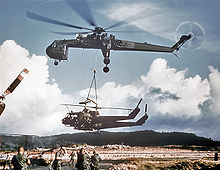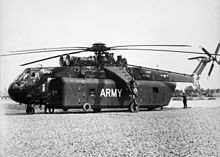Sikorsky CH-54
| CH-54 Tarhe | |
|---|---|
 A CH-54 transports a house |
|
| Type: | Transport helicopter |
| Design country: | |
| Manufacturer: | |
| First flight: |
May 9, 1962 |
| Number of pieces: |
105 |
The Sikorsky CH-54 Tarhe (Tarhe: crane in the Indian dialect of the Wyandot Indians, English cargo helicopter) is a turbine-powered transport helicopter made in the USA . Manufactured by the Sikorsky company , it had its maiden flight on May 9, 1962 . The model has its origin in the civilian Sikorsky S-64 Skycrane .
History of the helicopter
The prototype with the designation S-60 - first flight on March 28, 1959 - with a payload of 5,445 kg crashed in 1961. The basic components of the S-60 machine were based on the Sikorsky S-56 .
Since this type was originally intended to be produced for the German Bundeswehr , the following two specimens were tested by it. The prototypes were with two turbines of the type Pratt & Whitney equipped JFTD12-4A with each 3,020 kW (4,107 hp). These two test samples were delivered by Sikorsky to Weser Flugzeugbau , who developed the machines further, which is why the two specimens were also given the designation WFS-64A. However, there were no orders from the Federal Republic of Germany for the S-64 to the Sikorsky company. A Weser Skycrane was in use for SBB in Switzerland in the summer of 1964 to fly drilling material for geological drilling on mountain construction sites in the Gotthard region.
The US Army initially ordered six copies of the helicopter in June 1963. A total of about 60 machines of the type CH-54A were produced.
The successor version, the CH-54B, was equipped with the Pratt & Whitney T73-700 shaft turbines, each with 3,579 kW (4,867 hp).
Most of these helicopters were used by the USA during the Vietnam War - with the 478th and 291st Aviation Company - with the main task of transporting loads up to eleven tons, for example trucks, field hospitals, small ships, airplanes, other helicopters , complete workshops and troops. During a special mission, a Skycrane also dropped a 4,536 kg bomb to create a landing zone in a forest area.
The enormous load capacity was achieved through the concept with two Pratt & Whitney T73 P-1 turbines, each of which developed an output of 3,356 kW (4,564 hp).
Because of the large distance between the cockpit and the main rotor and the control rotor at the rear, the helicopter was equipped with a hydraulic transmission of the control commands to the rotors, which was the only way to work largely free of play and with little friction.
Since this helicopter was originally not developed for the army, but for civilian use, the rotor drive shafts were uncovered. This made maintenance and repairs much easier. Due to its long legs and dimensions, the Skycrane was able to stand over most of its loads.
A universal military container with the dimensions 8.36 m long, 2.89 m wide and 1.98 m high fit exactly under the CH-54.
In order to support the pilot and better control the payloads, the S-64 had a large window at the rear of its cockpit, from which a third crew member - the so-called crane operator - controls the helicopter when it is lifted and lowered, as well as during the flight Supervised the load.


The loads were transported either in exchangeable load containers or on steel cables. Some of these helicopters were also equipped with skids, which enabled landings on ice surfaces, for example.
In total, the US Army received 97 Tarhe helicopters between 1964 and 1972. Towards the end of their service life, they were replaced by Boeing Vertol CH-47 tandem rotor helicopters . At last only units of the National Guard were equipped with machines of this type. In 1993 the military service for the CH-54 ended.
Worth mentioning is the record flight of a Sikorsky CH-54B in 1972 to 11,200 m height, but in the same year by Frenchman Jean Boulet with a SA-315 improved "Lama" on 12,442 m and in 2002 by Frédéric North with a Eurocopter AS 350 continue could be increased to 12,954 m.
In 1992 Sikorsky sold the rights to the Skycrane to Erickson-Air-Crane Co in Oregon / USA. This company uses the machine - called the S-64 in the civil version - as a cargo helicopter on large construction sites and oil fields , for extensive forest work or as a fire-fighting helicopter .
variants
- YCH-54A
- Pre-production helicopters, six were built.
- CH-54A "Tarhe"
- The helicopter variant, known internally as the S-64E, was built in a series of 54 pieces with two 3,400 kW Pratt & Whitney T73-P-1 turbines.
- CH-54B "Tarhe"
- Of this stronger variant of the CH-54, internally designated as the S-64F, 37 machines were built. Compared to the CH-54A, it is equipped with the 3,600 kW T-73-P-700 turbine and double tires on the main landing gear.
- S-64E
- See CH-54A
- S-64F
- See CH-54B
Military users
Technical specifications
| Parameter | Data from the Sikorsky CH-54B |
|---|---|
| Hull length | 21.41 m |
| height | 5.67 m |
| Main rotor diameter (6-blade rotor ) | 21.95 m |
| Main rotor area | 378.10 m² |
| drive | 2 Pratt & Whitney T73-700 shaft turbines with 3,579 kW (4,867 hp) each
|
| Operating speed | 169 km / h |
| Top speed | 202 km / h |
| Service ceiling | 2,750 m |
| Range with a full tank (with 10% reserve) |
370 km |
| crew | 3 men |
| Empty weight | 8,981 kg |
| Max. Takeoff weight | 21,318 kg |
Sikorsky CH-54 in museums
- Pima Air & Space Museum, Tucson / Arizona (USA)
- United States Army Aviation Museum, Ozark / Alabama (USA)
See also
Web links
Individual evidence
- ↑ Cockpit, August 1964, p. 25
- ↑ http://www.airvectors.net/avskbig_1.html

